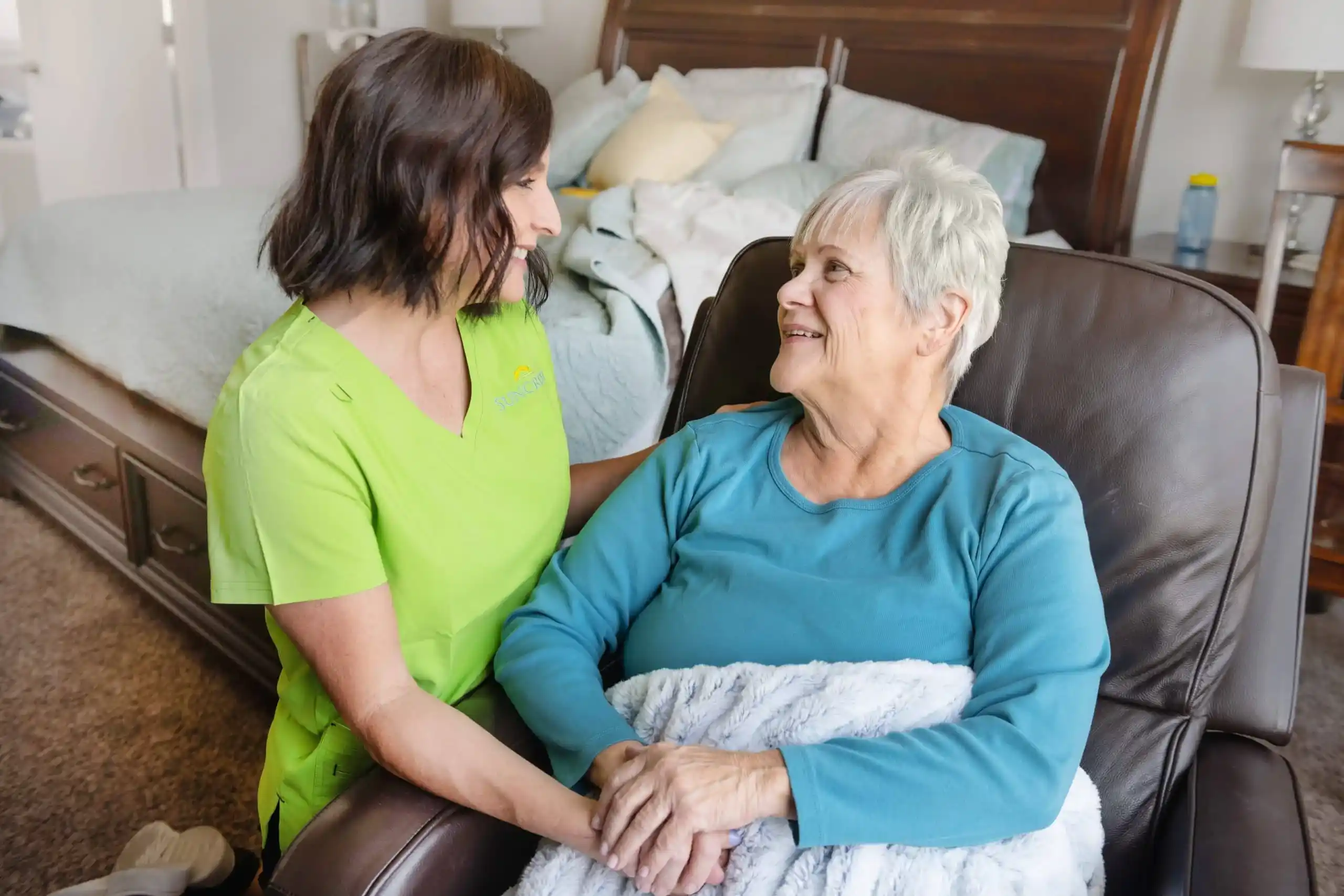November is National Hospice and Palliative Care Month, and as such, Suncrest Home Health and Hospice of Chicago wishes to do its part to raise awareness about hospice — what it is, who it helps and why it is important. The team at Suncrest works tirelessly every day to serve our hospice patients and their families, and our goal is to bring this valuable service to more patients who need it.
 National Hospice and Palliative Care Month
National Hospice and Palliative Care Month
President George W. Bush declared November National Hospice and Palliative Care Month in 2007. Bush’s mother, Barbara Bush, was in hospice care in 2018 before her death at the age of 92 due to a number of health issues, including COPD.
Bush’s proclamation has helped educate Americans everywhere about hospice and the services that are available to the terminally ill.
Despite the proclamation, however, many people in Chicago and across the U.S. are not fully aware of what hospice is and the benefits it can provide.
History of Hospice
The first hospice — St. Christopher’s Hospice in South London — was founded in 1967 by Dame Cicely Saunders, a British nurse, social worker and doctor. Saunders, who was 49 when she founded St. Christopher’s, had what was at the time considered a somewhat radical view of patient care.
To this day, many doctors consider the death of a patient a failure. Although this can sometimes be true, Saunders believed that it was not always the case. Death is a natural and unavoidable part of life, and extreme measures to stave it off are not always necessary or even welcome. She normalized allowing patients to choose how they want to die, and to refuse lifesaving treatment if they wanted to.
Another important change Saunders introduced to patient care was the idea that patients must wait to be in pain before getting another dose of medication. While under certain circumstances it may be advantageous to restrict the use of pain medication, Saunders believed this was not necessary for terminal patients, and was even cruel. Patients at St. Christopher’s reported a tremendous sense of relief when they learned they could get regular doses of pain medication.
Additionally, Saunders believed that opiate addiction for hospice patients was not a concern. In order to enter hospice, a patient must have a life expectancy of six months or less. During this time, she believed, it was not possible for opiates to negatively impact their lives.
Saunders also did away with traditional visiting hours that were common in hospitals. Although most facilities institute some type of visiting hours, these rules are much more relaxed in hospice than they are in hospitals. Often visitors are allowed all day long, from morning through evening.
Hospice: Spreading the Word
Dying with dignity became an oft-discussed topic after the 1969 publication of On Death and Dying, a book by Elisabeth Kubler-Ross that introduces the five stages of grief: denial, anger, bargaining, depression and acceptance.
In 1974, the first U.S. hospice was founded: Connecticut Hospice in Branford, CT. Today, there are around 5,000 hospice facilities operating in the U.S., and hospice care at home is being provided to hundreds of thousands of patients in per year in Chicago and across the country.
The Rules of Hospice Care
Many people erroneously believe that no medication is given in hospice care. The reason for this misnomer is because in order to enter hospice care, patients must give up on receiving lifesaving medications and treatments. For instance, a cancer patient in hospice would not undergo chemotherapy or radiation treatments.
Both these treatments cause unpleasant side effects such as nausea, vomiting, fatigue, hair loss, dry mouth, itching and skin problems. It is side effects just like these that cause patients to make the decision to forego lifesaving treatment and enter hospice care. Many patients become tired fighting their illness, and when hope dwindles, they want to use their remaining stores of energy to enjoy their last days.
In hospice care, however, we do provide a number of medications, the most important of which are pain relievers, which may be orally or intravenously administered. Pain relief is one of the main tenets of hospice, and it is the intention of every hospice worker to prevent their patients from suffering any pain unnecessarily.
Other medications we may provide in hospice include sleep aids, antidepressants, antianxiety medications, medication to control nausea and vomiting, and anticholinergics to control spasms. The underlying philosophy of hospice is that the medications we give are those that make patients more comfortable.
Because hospice care is end-of-life care, in order to be accepted into the program, patients must have a referral from a doctor that says you are expected to live six months or less.
Naturally, when people hear this, they wonder what happens if the patient is still alive after six months. What we do at this time is reevaluate patients, and if they are not expected to live another six months, they can remain in hospice.
If, however, they have unexpectedly improved, they may be discharged. In reality, however, the vast majority of hospice patients die within days of entering the program.
What Happens in Hospice Care?
Hospice care can be delivered at home or in a hospice care facility. Sometimes the decision comes down to availability. If no local hospice centers in Chicago have room for a new patient, your only option may be to arrange for hospice services at home.
Some hospice facilities are located within hospitals or nursing homes. They are set up much the same way as the traditional rooms with hospital beds, but an attempt is usually made to make the rooms seem more homey and less sterile.
Many hospice patients prefer staying at home in familiar surroundings during their last days or weeks, but this is not always possible when family members are unable to be present to help with their care. If the patient can’t be left alone and family members must work or look after children, or they are elderly and frail themselves, then hospice patients are safer in a facility.
Suncrest Home Health and Hospice provides in-home hospice care throughout Chicago. Our hospice nurses and social workers meet with families and patients to determine their needs and create a plan of care. Services are provided by:
- Home health aides — Certified nursing assistants come into the home, usually daily, and help the patient with bathing, dressing, toileting, eating and other tasks of daily living. They also change bedsheets and may do some light housekeeping, such as laundry.
- Hospice nurse— The hospice nurse visits patients in their homes to create the plan of care, then makes regular visits thereafter to check vitals, adjust medication doses and provide other necessary medical care.
- Social workers— Social workers help with coordinating all the services hospice patients need and they provide educational services about how hospice can help patients and families.
- Counselors— Therapists provide counseling to patients who can benefit from talking to a professional about coping with their impending death.
- Speech, occupational and physical therapists— Just because someone is in hospice doesn’t mean they can’t improve some areas of their lives. In fact, we encourage improvement whenever possible. Therapists can help patients regain strength, happiness and dignity.
- Spiritual advisors— Not everyone is religious, but those who are sometimes enjoy visits from a priest, rabbi or minister. Even if you don’t practice any religion, our team can arrange a visit from a spiritual advisor. These often bring patients comfort in their last days.
When they are not receiving care or therapy, patients often doze in chairs or hospital beds. Depending on their level of strength, they might read, watch TV, chat with visitors or enjoy hobbies such as doing jigsaw puzzles or needlework.
The main goal of hospice is to keep patients comfortable. Beyond this, if we are able, we try to contribute to increasing their peace and happiness.
What Is the Difference Between Hospice Care and Palliative Care?
You sometimes see the terms hospice care and palliative care used interchangeably, but they are not exactly the same. Both provide comfort care and aim to relieve the symptoms of disease. But palliative care is not only for terminal patients.
The goal of palliative care is to improve quality of life. For instance, if a patient has emphysema, which is a long-term, chronic illness that causes severe shortness of breath, palliative caregivers provide medications and teach patients coping skills to make living with their disease easier. With palliative care, patients also do not give up lifesaving medications and treatments if they don’t want to.
Hospice Care in the Chicago Area
If you or a loved one has been diagnosed with a terminal illness, you have many choices to make ahead of you. The road for terminal illness can be long, and hospice care is at the very end.
Not everyone chooses hospice care — some patients fight to the end. What’s important is that they have the choice. They can choose to die peacefully, in their own home, ensured of physical comfort and familiar surroundings.
As hospice care providers, we hope that National Hospice and Palliative Care Month spreads more awareness about the availability of this type of care to terminally ill patients. At Suncrest Home Health and Hospice of Chicago, we work hard to make our patients’ final days easier and more peaceful.


